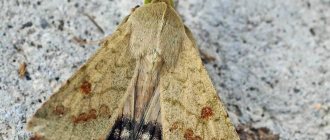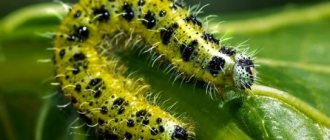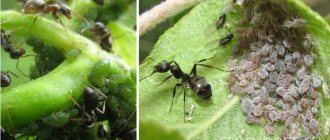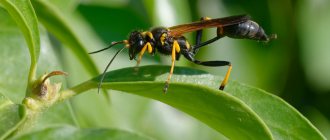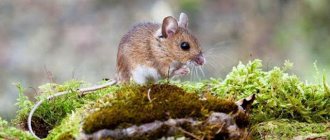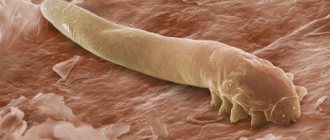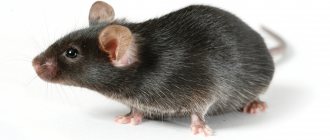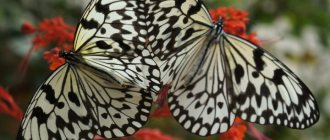Butterflies are a true miracle of nature. People call them fresh flowers and admire and adore them. How does the transformation from a caterpillar into a butterfly occur - stages of development.
Even small children know that a clumsy caterpillar turns into a gentle and graceful butterfly. But the details of the transformation process may surprise even adults.
Types of butterfly eggs
Butterfly eggs come in various shapes - round, flattened, oval, spindle-shaped, smooth or with a cellular surface, covered with spines or ribs. The color of the eggs is also different, most often whitish, light green or yellow, in addition, brownish, brownish-violet, reddish. The eggs of many species change color as they develop.
The manner in which eggs are laid may differ among different species of butterflies. Eggs can be laid one at a time or several at a time, or in large groups, up to several hundred in one clutch. Eggs can be laid on leaves, stems, flowers, fruits of plants, in cracks in tree bark, on soil, lichens, and on dry plant remains. After laying, females of some species cover their eggs with hairs from their abdomen.
Defense strategy
You may be interested in:Top 5 unusual spiny flowers and plants
All types of butterflies and moths begin life as a caterpillar. This is a very vulnerable form of the insect and therefore needs protection.
Their appearance varies greatly, especially with regard to coloration, which plays a major role in their ability to protect themselves from predators. In many cases, their coloration is meant to mimic the appearance of their surroundings, and this changes as they grow. For example, the young larvae of many swallowtail butterflies (Papilio) are white and brown, resembling bird droppings on the leaves, but over time their appearance changes such that the colors eventually become camouflage, allowing them to blend into the leaves and stems of plants . In some caterpillars, coloration is noticeable or enhanced by the presence of features such as false organs of vision, which can deceive or frighten predators.
Other defense strategies used by caterpillars include secreting foul-smelling substances, using sounds, generating vibration signals, and sequestering chemicals into tissues that are toxic to predators. Caterpillars of the great night peacock eye (Saturnia pyri) send out ultrasonic warning signals to deter predators. The caterpillar of the sicklewing butterfly (Drepana arcuata) produces vibration signals to defend its territory from intruders of the same species; she knocks her jaws on the surface of the leaf and scratches it with her hair-covered feet.
Monarch butterfly (Danaus plexippus) larvae rely on a defense system associated with their unique ability to feed on milkweed (Asclepias) plants. These plants produce compounds known as cardenolides, which are typically toxic to animals. Monarch butterfly larvae are not affected by the poison, and they are able to sequester the compound in their tissues. Since the poison remains in insects during subsequent stages of development, they are toxic to vertebrate predators, both as larvae and as adult butterflies.
Caterpillar structure
The body of caterpillars consists of thirteen segments, of which three are thoracic and ten are abdominal. The thoracic segments bear a pair of jointed legs; the abdominal segments usually have five pairs of false legs; some types of abdominal legs have two or three pairs, or they are underdeveloped. The appearance of caterpillars is very diverse and often differs even among closely related species.
Many are brightly and variegatedly colored, some have outgrowths in the form of horns, spikes, and bumps. The surface of the body is smooth with sparse scales or covered with dense hairs, warts, and spines. Body proportions also vary: some caterpillars are short and thick, others are thin and long.
Interesting Facts
- Are butterflies dangerous for humans? No, but there is an exception, this is the Saturnius butterfly. It is true that it is not the butterfly itself that is dangerous, but its caterpillar, which secretes poisonous toxins that can even kill a person. (fortunately, such butterflies and caterpillars do not live in our latitudes).
- The migratory monarch butterfly is a true champion in endurance; it is capable of flying up to 1000 km at a time, without even stopping to rest.
- If the monarch butterfly is a champion in endurance, then hawk moths are real record holders in the insect world for speed; they can reach speeds of up to 60 km per hour over short distances.
- Butterflies do not sleep either at night or during the day, since they absolutely do not need sleep.
What do caterpillars eat?
Caterpillars of most butterfly species feed on green parts of plants - leaves, flowers, unripe fruits. Some develop inside branches and trunks, feed on wood, on lichens and dead parts of plants, on animal remains such as wool, down, feathers, and also on wax.
Some species are predatory, feeding on ant larvae and scale insects.
Benefits and harms
Butterflies can be both beneficial and harmful to agriculture. So, being in the caterpillar stage, they are plant pests; due to eating the leaves of fruit trees, the harvest deteriorates, or even is completely lost. On the contrary, adult butterflies bring great benefits, since they promote cross-pollination and self-pollination of many plants.
You can also separately highlight the silkworm, which is a producer of natural silk, which has been of great value since ancient times.
Transformation of a caterpillar into a butterfly - the pupa stage
Pupation is the most vulnerable process in the butterfly's development cycle, and most caterpillars prepare carefully for it. The pupal stage in different species can last from several days to several years. A long pause (stop in development) of pupae is an adaptation that allows the species to survive unfavorable years. If in the first year unsuitable conditions arise and the butterflies emerging from the pupae die, the population is replenished by previously diapausing pupae that emerge the next year.
The butterfly formed inside the pupal shell has very short, soft wings. When emerging from the pupa, it needs to climb onto some vertical surface in order to hang its wings, which will give them the opportunity to straighten. After which the wings gradually harden, and during this time the butterfly sits motionless.
Ursa
The front wings of this butterfly are dark brown, the span is 50 - 80 mm. The hind wings are red-yellow with black or dark blue spots. Dipper caterpillars are densely covered with brown hairs, which is why the butterflies got their name. Caterpillars feed on plants, some of which are poisonous. The poison accumulates in their body and remains in the body even after the caterpillars turn into butterflies. The venom of some species can be fatal to small animals.
Ursa
Butterfly structure
The butterfly's body consists of three sections - the head, thorax and abdomen, which contains internal organs.
The head bears antennae, palps, complex compound eyes and mouthparts. The vast majority of butterflies have mouthparts of the sucking type and are a thin long tube-proboscis, which is curled into a spiral when at rest. Many butterflies have underdeveloped mouthparts and are thus unable to feed, subsisting on energy reserves accumulated during the caterpillar stage.
The antennae of butterflies are an organ of smell and come in various shapes - filamentous, club-shaped, feathery, comb-shaped and others. The sense of smell of some butterflies is very developed; males of such species are able to detect the scent of a female at a considerable distance.
The chest of butterflies bears three pairs of jointed legs and two pairs of wings, while the females of some species have underdeveloped wings or are completely wingless, and in some species they are also legless. The pattern on the wings of butterflies is formed by the scales covering them, hence the scientific name of the order - Lepidoptera.
Nutrition
What do butterflies eat? Pollen and nectar from flowering plants are the main diet of butterflies. Some species of butterflies are not averse to feasting on tree sap and rotten fruit. There is also such an interesting butterfly as the dead-headed hawk moth, it is notable for the fact that it likes to fly into the hive to
bees feast on their honey.
Sometimes among butterflies there are real gourmets, for example, some tropical butterflies drink tears
turtles crocodiles.
Interesting fact: among butterflies, there are also those that completely lack mouthparts. How do they eat?! But in no way, the fact is that in order to maintain life, they use up the reserves of nutrients that they accumulated when they were still caterpillars. One such unusual butterfly is the Madagascar comet. Of course, life expectancy with such nutrition (or rather the complete absence of it) is only 2-3 days.
Among the numerous kingdom of butterflies, there is also a real vampire butterfly, which, like
The mosquito feeds on the blood of other animals.
Types of butterflies
The color of butterfly wings is varied. In some they are beautifully and brightly colored, while in others, on the contrary, they have a modest protective color, allowing them to be invisible on flowers and herbs, tree bark, stones, and lichens. Many species are characterized by sexual dimorphism, that is, a pronounced external difference between male and female in color, shape and size of wings, as well as in the structure of the antennae. Occasionally there are individual, atypically colored individuals called aberrants.
Gynandromorph butterflies, that is, individuals that combine the characteristics of a male and a female, are extremely rare. Gynandromorphs of species that are characterized by pronounced sexual dimorphism look very unusual. In this case, on one side of the butterfly’s body there are wings with the color of the male, and on the other - with the color of the female.
Most butterflies are active at dusk and at night, with a much smaller number of species active during the day. However, it is the diurnal butterflies that are the most visible, and, as a result, the best studied. Many butterflies are good flyers; some species are characterized by regular migrations, which often leads to their wide distribution. Others, on the contrary, inhabit only small geographical regions; such species are called endemic.
Wintering
What do butterflies do in winter? Butterflies living in tropical latitudes have it easier in this regard, but our butterflies living in a temperate climate zone have to survive the winter cold, how do they do it? Some butterflies do not survive the winter, they live only in the summer, during which time they leave offspring that survive the winter in the form of pupae. But there are also species of butterflies that survive the winter cold by hiding in tree hollows or deep cracks in the bark. Also, some species of butterflies, like birds, with the onset of cold weather, rush to fly to warmer climes. For example, such travel butterflies are the monarch and the oleander hawk moth.
